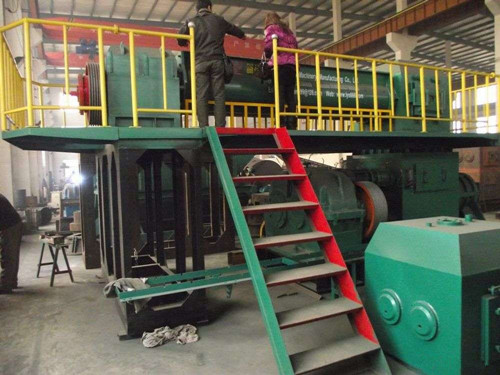 Brick block machine
Brick block machine Conveyor
Conveyor Automatic stacker crane
Automatic stacker crane Mixer
Mixer JS500 concrete mixer
JS500 concrete mixer JZC350 concrete mixer,concrete
JZC350 concrete mixer,concrete  Tilting drum concrete mixer
Tilting drum concrete mixer Eight hole brick machine
Eight hole brick machine Raw material mixer
Raw material mixer Belt Conveyor
Belt Conveyor Concrete block stacker
Concrete block stacker Wheel roller mixer for brick ma
Wheel roller mixer for brick ma Hydraulic brick machine
Hydraulic brick machine Electronic batching machine
Electronic batching machine Bucket elevator
Bucket elevator Setting machine
Setting machine Steam curing car
Steam curing car Autoclave
Autoclave News
News
Tempering is adding water to the clay soil in order to make it more workable. Too much water added to the clay mix will decrease quality, though.
An alternative to tempering is disintegration or weathering, which involves allowing clay to dry in the sun and accept moisture from rain and dew. The repeated drying and moistening of clay will bring clay to a plasticity and workability appropriate for brickmaking. Crushing will make the mixture more homogeneous.
Mixing is done to make the clay soil homogeneous and smooth. There are different techniques that can be used to do this, including using animal power or letting humans mix the clay with their feet. Different admixtures such as coal or sawdust can be added to the clay for two beneficial reasons: 1) reduce cracking during drying and 2) reduce fuel usage during firing.
MoldingBricks should have standard characteristics if they are to be used in construction. For example, contractors may buy bricks from several different sources for one project: the bricks must be the same size or there will be problems matching the construction of different sections of the building. Moreover, a standard brick size will allow a contractor to more accurately determine how many bricks will be needed for a project. A new brickmaker, therefore, should follow local standards, checking with other brickmakers in the area or with local authorities or construction contractors.
When determining the size of a mold for brickmaking, a necessary consideration must be shrinkage. Bricks will shrink when drying, so the mold size must be larger than the intended finished brick.
In slop molding, a wet clay mixture is used- the mix is put into a rectangular form without a top or bottom. A problem with this technique is that because the mix is so wet, the brick may deform under its own weight and the surface can be marked easily.
Sand molding utilizes a drier clay mix, formed into a wedge and thrown into a mold. A bow cutter will be used to smooth the top of the brick, and the form will can be released because of a hinged bottom. Since the clay is drier, the brick can be moved with wooden palettes which can reduce the amount of surface marks. There are multiple benefits to using sand molding instead of slop molding, such as:
Water was added during clay preparation to increase workability of the mixture, but in drying it is removed for several reasons. First, there will be less cracking in fired bricks with less water content. Second, additional fuel is needed, beyond what is used for firing, to dry the bricks in the kiln. Proper drying of bricks will involved rotating the bricks for different exposures to ensure even drying rates.
For best results, drying should be done slowly. This will help with more even drying. Also, the best drying technique may change from location to location, so the brickmakers must gain experience to determine the best way to dry bricks for each production process.
Firing
A clamp is a field kiln built from the green bricks that will be fired. Clamps vary with size and shape and must be oriented with respect to wind direction. Once a clamp is laid out and constructed, it must be insulated.
Finally, the process of firing the clamp will take place in several steps. First, pre-heating, or water-smoking, will remove the water leftover from the drying process. This process is still physical. The second stage is firing, where the clay bricks will vitrify through a chemical process. The temperature must remain constant at this stage for complete vitrification. Finally, for the cooling stage, the temperature must be slow and steady. A clamp may take two weeks to cool.
| Model |
(standard) block/h |
Forming moisture | MPa | Kw |
| JKY60/60-40 | 18000-24000 | 14%∼16% | ≤0.092 | 90+200+7.522* |
| JKY55/55-40 | 14000-20000 | 14%∼16% | 75+160+7.5 (22)* | |
| JKY50/50-40 | 12000-16000 | 14%∼16% | 55+132(160)+5.515* | |
| JKY50/50-35 | 13000-18000 | 15%∼18% | 55+132+5.515* | |
| JKY45/45-35 | 11000-15000 | 16%∼20% | 55+110+5.515* | |
| JKB40/40-25 | 8000-10000 | 18%∼20% | 45+90+5.515* |